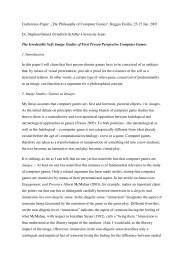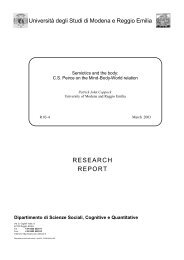Playing Dress-Up: Costumes, roleplay and imagination
Playing Dress-Up: Costumes, roleplay and imagination
Playing Dress-Up: Costumes, roleplay and imagination
Create successful ePaper yourself
Turn your PDF publications into a flip-book with our unique Google optimized e-Paper software.
<strong>Playing</strong> <strong>Dress</strong>-<strong>Up</strong> Ludica<br />
<strong>and</strong> clothing allows players to literally “dress for the occasion,” possibly even changing their<br />
entire form for a specific locale or theme.<br />
• Team Sport <strong>and</strong> Combat: Both Taylor <strong>and</strong> Pearce’s research support a rich nuance of<br />
competitive play among women <strong>and</strong> girls, which will be explored further in another paper.<br />
However, what bears mentioning in the context of costume play is the pleasure of not only being<br />
strong, but also of appearing strong. In other words, though “gear” is a masculine framing of<br />
fashion, women can also enjoy fashion as “gear.”<br />
Taylor also identifies creative production as a pleasure of gaming, which she illustrates with examples of<br />
fan art created by female EverQuest players, primarily self-portraits of their avatars. Creativity within<br />
EverQuest, however, is quite limited, so this is not really enumerated as a game mechanic. (Taylor<br />
2003A)<br />
<strong>Playing</strong> with—And Against—Gender<br />
While an entire book could be devoted to the subject of gender dress-up in games, a subject that is equally<br />
under-studied, this paper would not be complete without at least touching on this complex theme. We<br />
know very little about this topic, but what we do know about gender play in games <strong>and</strong> virtual worlds is<br />
that it has an entirely different social function that real-world transgender play, although it may resemble<br />
some earlier cultural practices of costume-play. We will touch on a few aspects of gender-play here, but<br />
this subject warrants much more extensive study.<br />
One affordance that games provide is a framework for experimentation – trying out various gender roles<br />
in specific social contexts. As Brunner et al elucidate in the influential book on games <strong>and</strong> gender, From<br />
Barbie to Mortal Kombat:<br />
One of the functions of playing games, as Henry Jenkins (this volume) notes, is to rehearse <strong>and</strong><br />
explore what it means to have a gender. Games provide a safe place to explore issues of femininity<br />
<strong>and</strong> masculinity. Game playing can deliberately exp<strong>and</strong> our sense of who we are. The appeal of<br />
role-playing games among both children <strong>and</strong> adults is testimony to this fact. (Brunner et al 1998, p.<br />
81)<br />
There are many examples of gender play in art <strong>and</strong> literature. Marcel Duchamp <strong>and</strong> Man Ray were<br />
notorious for their playful female avatars, <strong>and</strong> Frida Kahlo appears in men’s clothing in a number of her<br />
self-portraits. (Smith 1997) A number of women authors, including George Eliot (Mary Anne Evans),<br />
George S<strong>and</strong> (Am<strong>and</strong>ine-Lucile-Aurore Dupin), <strong>and</strong> Jane Bowls cross-dressed <strong>and</strong> posed for photographs<br />
in men’s clothes. Virginia Woolf, though not a cross-dresser, explores gender swapping in depth in her<br />
novel Orl<strong>and</strong>o (later adapted for film by Sally Potter). This intriguing “mockumentary” follows the<br />
history of a fictional character who lives through multiple generations <strong>and</strong> switches genders halfway<br />
through his/her 400-year lifespan. Woolf observes that “clothes make the woman” in describing<br />
Orl<strong>and</strong>o’s transition from male to female:<br />
…clothes have, they say, more important offices than merely to keep us warm. They<br />
change our view of the world <strong>and</strong> the world’s view of us [. . .] So, having now worn skirts<br />
for a considerable time, a certain change was visible in Orl<strong>and</strong>o [...]. If we compare the<br />
picture of Orl<strong>and</strong>o as a man with that of Orl<strong>and</strong>o as a woman we shall see that though<br />
both are undoubtedly one <strong>and</strong> the same person, there are certain changes. The man has<br />
his h<strong>and</strong> free to seize his sword, the woman must use hers to keep the satins from slipping<br />
from her shoulders. (Woolf 1928, p. 132)<br />
Philosophy of Computer Games 2007 Page 17






